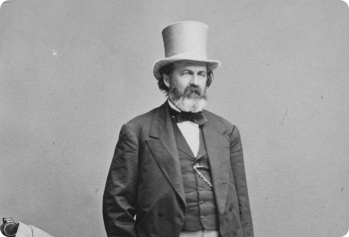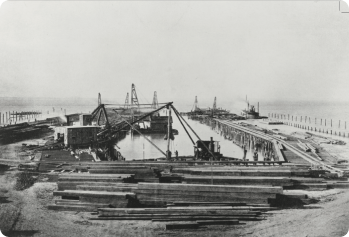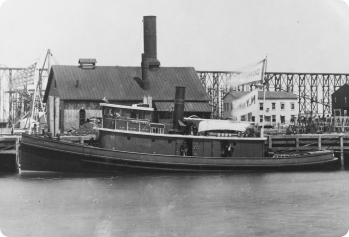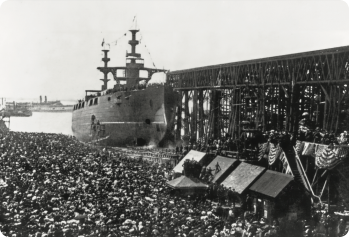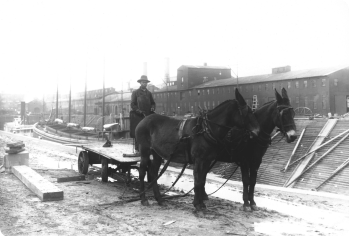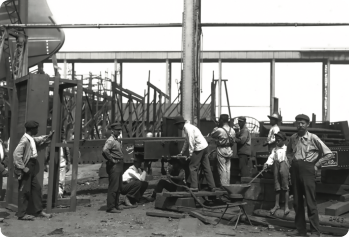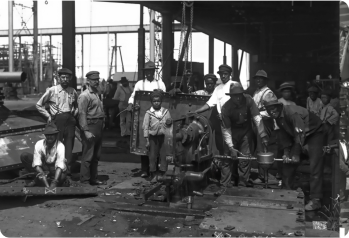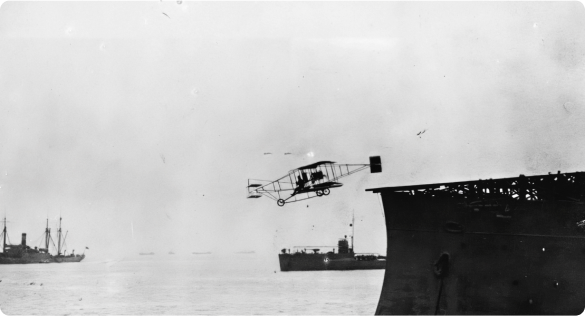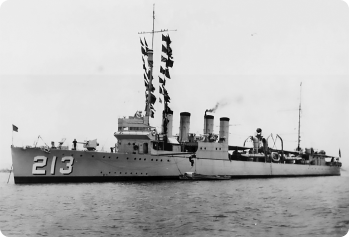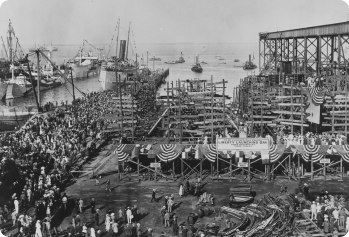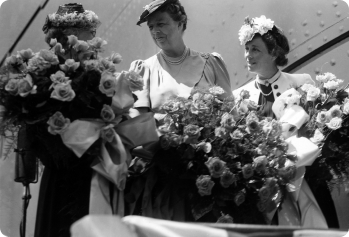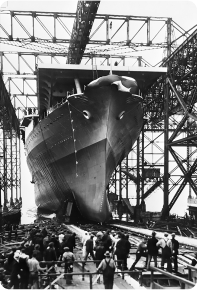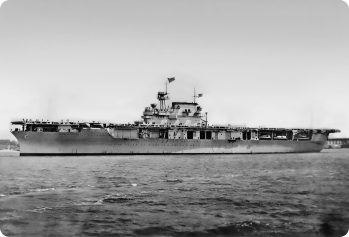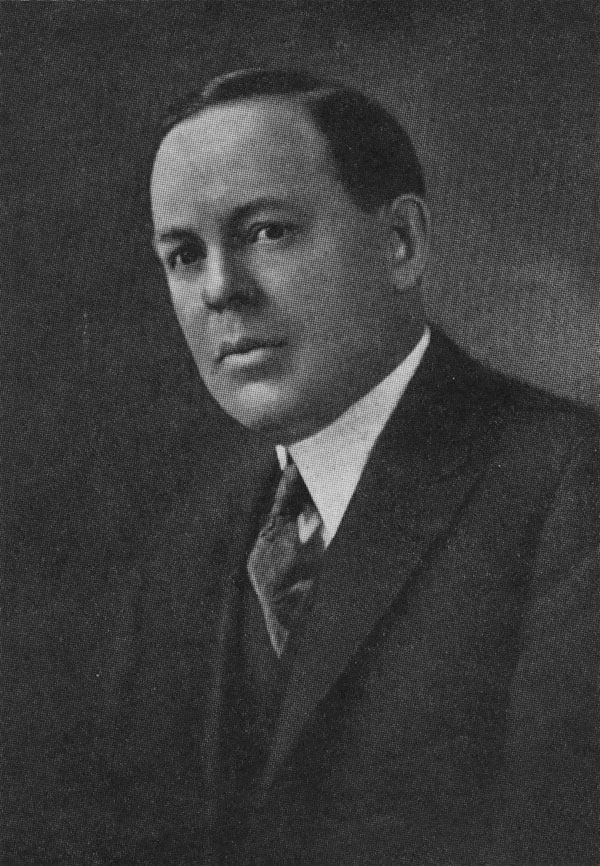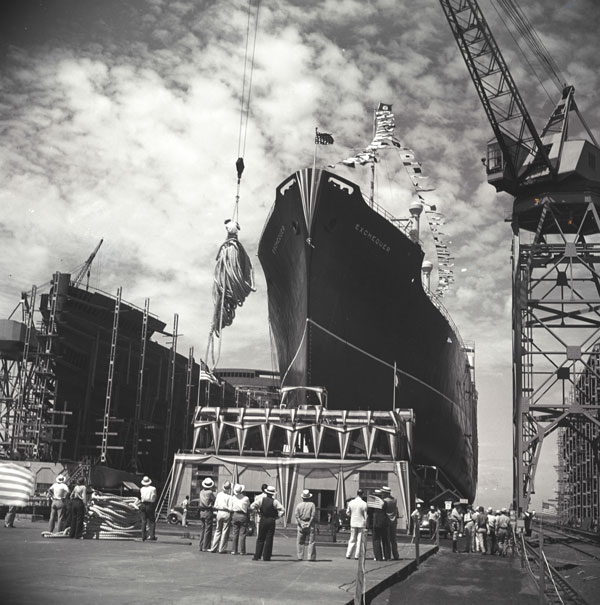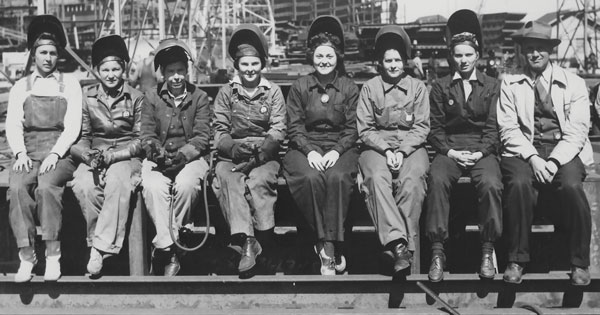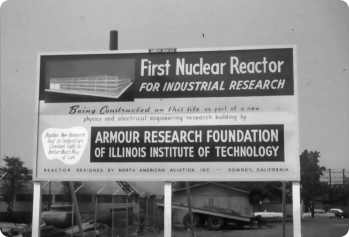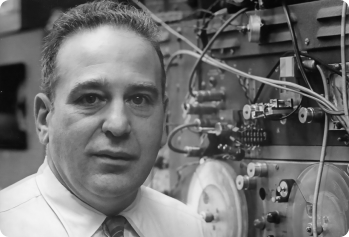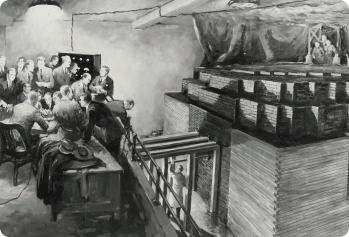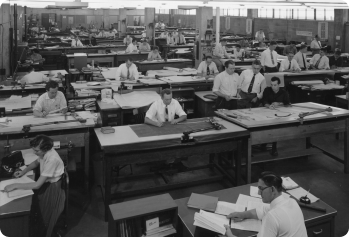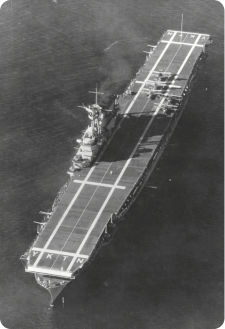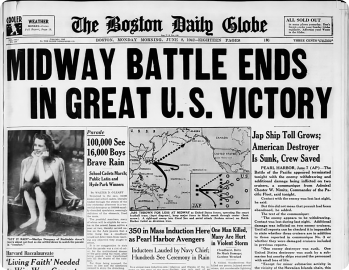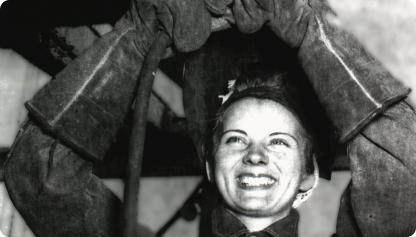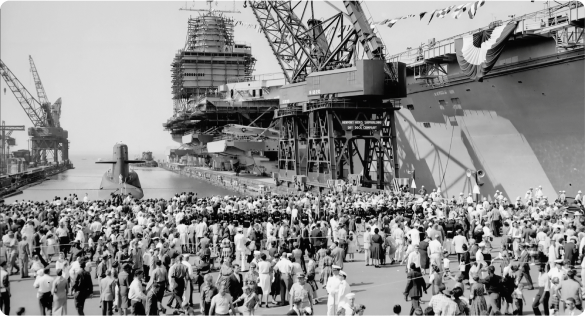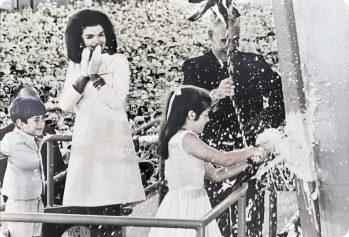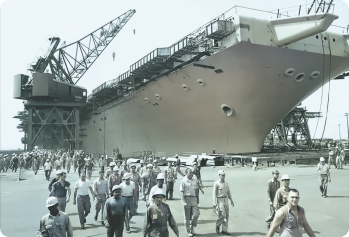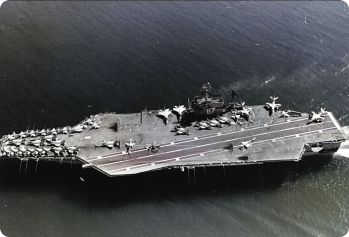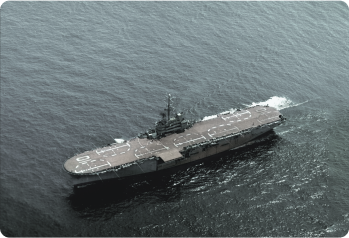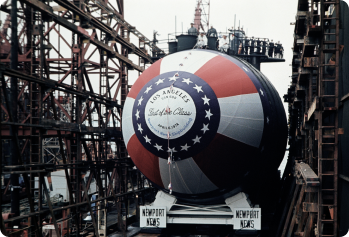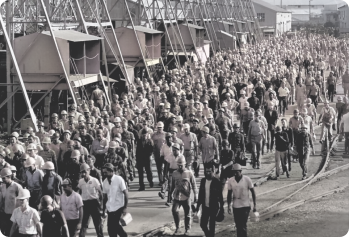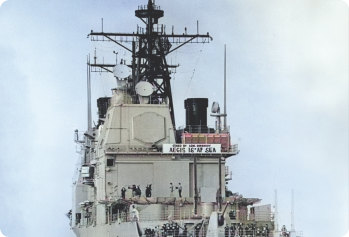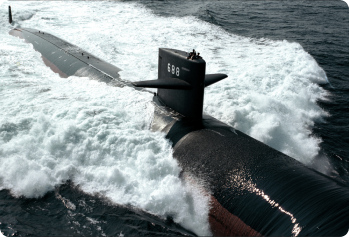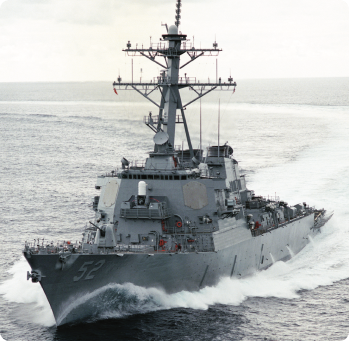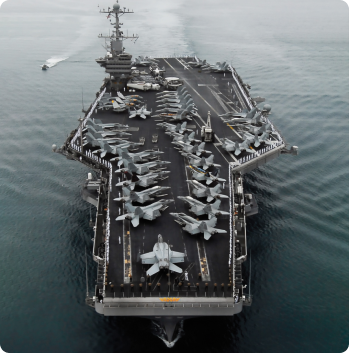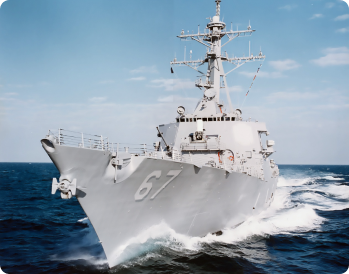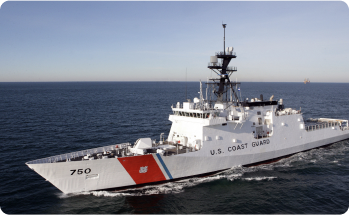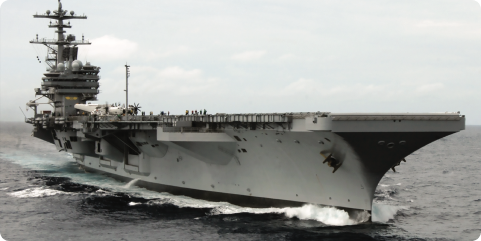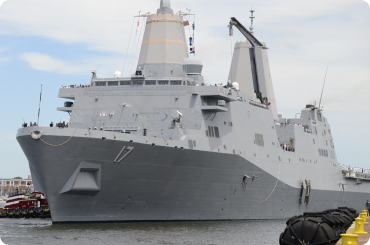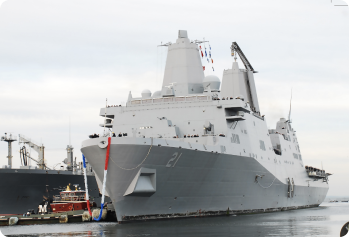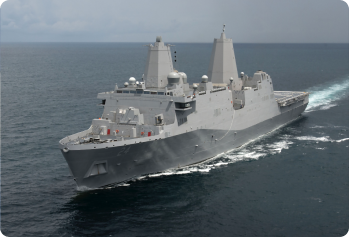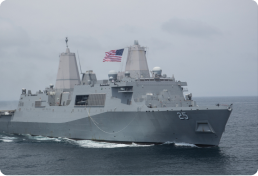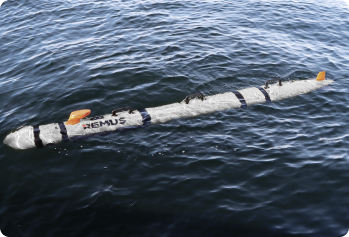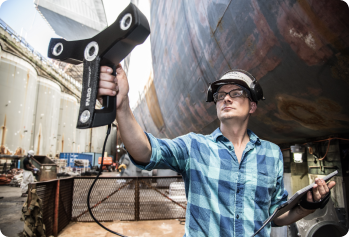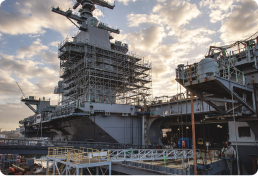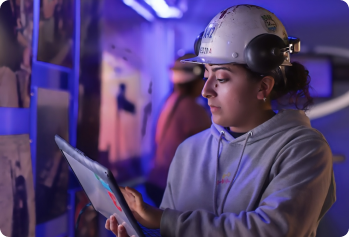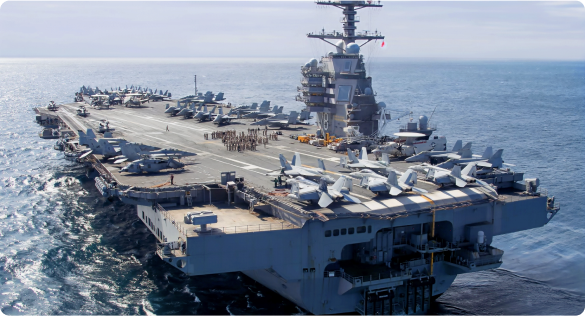Born in 1821, industrialist and railroad magnate Collis P. Huntington is among the “Big Four” businessmen whose investments enable completion of the U.S. transcontinental railroad, transforming American trade, commerce and travel. His focus on coastal Virginia comes to re-shape naval shipbuilding and set the stage for lasting American maritime strength.
In the 1870s, Huntington funds construction of rail lines that extend the C&O Railroad to the Virginia port town that becomes Newport News. This allows for transport of coal and other cargo.
To repair ships servicing this transportation hub, Huntington establishes Newport News Shipbuilding and Drydock Company in 1886. It becomes the largest privately owned shipyard in the United States.
There are 104 names on the Newport News Shipbuilding (NNS) payroll in September, 1889, each paid an average of $2.75/day.
NNS delivers its first ship in 1891, the tugboat Dorothy, named for the 4-year-old daughter of Secretary of the Navy William C. Whitney.
In the 1890s, NNS begins construction of gunboats for the U.S. Navy.
In a letter congratulating the shipyard president at the time, Calvin B. Orcutt, on contract wins, Huntington writes: “… what I want is to get a reputation for building first-class ships and then always build ships to sustain that reputation. I find there is more money made in doing things this way; and, outside of money there is great satisfaction in doing work well.”
Payroll swells to 4,500 workers by the turn of the century, and the launching of battleships becomes a celebratory event.
Special trains transport 30,000 people to Newport News to attend the launching of battleship USS Virginia (BB 13) in 1904. The state of Virginia declares it a holiday.
NNS builds seven of the 16 battleships that circle the globe as part of President Theodore Roosevelt’s Great White Fleet. The president dispatches the ships in 1907 on a round-the-world voyage to project U.S. military strength.
In 1910, Eugene Ely foretells the coming of the aircraft carrier when he flies off the deck of a cruiser in Hampton Roads. The small plane rolls off the bow, dips its propeller and wheels to the water before climbing skyward and a few minutes later descends onto dry land.
The development of the aircraft carrier, two world wars, and the Great Depression are ahead.
The man who leads the shipyard through this tumultuous chapter is U.S. Naval Academy graduate and naval architect Homer L. Ferguson. Ten years after coming to work at the yard, Ferguson is elevated to NNS president when his predecessor, A.L. Hopkins, perishes on the passenger ship Lusitania in 1915 when it is sunk by a German U-boat.
“Preparedness” becomes the nation’s watchword. Congress enacts the emergency naval program of 1916, authorizing construction of 10 battleships, six battle cruisers, and a number of smaller warships.
By the time Congress declares war on Germany in 1917, NNS is the company in a company town. There are about 7,600 workers on the NNS payroll; by the following year employment rises to more than 10,000.
Shipyard workers are housed at nearby Hilton Village in 1918 in one of the nation’s first federally financed housing communities, and the Newport News Apprentice School is formalized. More than 400 apprentices complete their training and are certified in 1919 in a training program that later earns national recognition.
Under Ferguson’s leadership, NNS fast-tracks emergency shipbuilding, swiftly filling requests for “Liberty Ships” needed for the war effort.
On July 4, 1918, known as Liberty Launching Day, NNS launches three destroyers. The shipyard delivers 25 destroyers to the U.S. Navy by 1920.
Shipbuilding slows in the 1920s due to disarmament treaties. To maintain the workforce through this period, the shipyard temporarily diversifies by building barges, turbines and box cars. “The men in our yard who have grown up with the great art of shipbuilding,” Ferguson tells a banquet of the Society of Naval Architects and Marine Engineers in 1922, “cannot be replaced; it took 20 or 30 years to make them competent to do their work.”
In 1930, NNS is awarded the contract for the first ship to be designed for the U.S. Navy as an aircraft carrier from the keel up. It is named USS Ranger (CV 4) in honor of the sloop commanded by John Paul Jones in the American Revolution.
Ranger is launched in 1933 by first lady Mrs. Lou Henry Hoover, who smashes a bottle of grape juice against the bow. (Prohibition was not repealed until later in the year.)
Soon after, the Navy awards contracts to NNS for two bigger, faster carriers: USS Yorktown (CV 5) is launched by first lady Mrs. Eleanor Roosevelt in 1936 and commissioned the next year; the “Big E” – USS Enterprise (CV 6) – is commissioned in 1938 and goes on to become the most decorated warship of the U.S. Navy in World War II. The name is passed to the world’s first nuclear-powered carrier, also built at NNS.
The third and last ship in the Yorktown class, USS Hornet (CV 8), is commissioned in October of 1941, just over a month before the Japanese strike Pearl Harbor.
NNS also delivers passenger ships during these years including USS America in 1940, also sponsored by Mrs. Roosevelt, which is the largest yet built passenger liner constructed in an American shipyard. As with others, the liner is converted to a troopship for service in the war.
In 1938,. Robert Ingersoll Ingalls Sr. (1882-1951) founds Ingalls Shipbuilding on the east bank of the Pascagoula River in Mississippi.
Two years later, Ingalls completes construction of its first ship, SS Exchequer. It is the first ship to include steel plates of its hull welded end-to-end, instead of overlapped and riveted. This revolutionizes shipbuilding and design Exchequer is acquired by the Navy in October, 1940, and renamed USS Pocomoke (AV 9). It receives two battle stars for service in the war in the Pacific.
American shipbuilders from all walks of life find opportunity and purpose building what President Franklin Delano Roosevelt calls “the arsenal of democracy.” fueled by industrial innovation and partnership in service of the war effort.
The output is extraordinary: NNS delivers 46 ships during the war. Rolls grow to 10,000 workers and collective bargaining is established at the shipyard. With unrelenting wartime demand for ships, NNS establishes an emergency yard on the banks of the Cape Feqy River called North Carolina Shipbuilding Company. which launches its first ship in 1941.
The Navy orders Essex-class carriers starting in 1940. The larger and more modernized version of the Yorktown- class goes on to become the backbone of the American fileet. By April 1945 NNS delivers eight aircraft carriers in less than 30 months, or one every 90 days.
Hll’s technology roots are found in the lead-up to Japan’s surrender, through scientists involved in the Manhattan Project.
These scientists, part of Armour Research Foundation (ARF) and the Illinois Institute of Technology (IIT), contribute to the first-ever sustained nuclear reaction in 1942, a vital milestone toward the atomic bomb that brings Japan’s surrender and an abrupt end to the war.
Research areas also include computer simulations, spacecraft thermal protective coatings (developed into the white paint used on every NASA mission since the 1960s), energy work and mining engineering. The modern cellphone is developed here, and early research into magnetics gives rise to early wire recorders (fostering modern tape recording) and later the new field of computer science.
Among the scientists is Marvin Camras of IIT, whose inventions transform recording technology and electronic communications.
It is out of ARF and IIT that Alion Science and Technology is born, made up of IIT’s science and engineering divisions. Alion is later acquired and integrated into HII’s Mission Technologies division.
During this period, scientific research yields breakthroughs in nuclear power and propulsion. In the coming decade, nuclear advancements revolutionize the U.S. Navy and form the basis of strategic nuclear deterrence.
NNS- and Ingalls-built ships are credited with essential contributions in both theaters of the war.
The three ships comprising the Yorktown class of carriers become the most famous fighting ships of the war in the Pacific.
In 1942, General Jimmy Doolittle’s raiders fly their B-25 bombers from the deck of USS Hornet (CV 8) for a daring surprise attack on the Japanese mainland nearly 700 miles away. It and its sister ships are central to the most important naval victory of the war in the Pacific, the Battle of Midway.
In June 1944, C3 cargo ships built by Ingalls Shipbuilding – USS Samuel Chase (APA 26) and USS Henrico (APA 45) – launch Higgins boats loaded with troops to Normandy on D-Day, the largest amphibious invasion in history that begins the liberation of France and lays the foundation for the Allied victory.
Reflecting the genuinely “all hands on deck” engagement in wartime shipbuilding, welder Vera Anderson wins multiple titles at Ingalls Shipbuilding in 1944, including Women’s National Welding Champion.
One year later, on the day Japan surrenders in 1945, Secretary of the Navy James Forrestal writes to Homer Ferguson, president of NNS: “You and all the men and women who have worked with you deserve to carry into peace a special pride in a great national achievement.”
In 1953, construction begins at Ingalls on the USS Thomaston (LSD 28), the lead ship in the Thomaston class. Ingalls goes on to build all eight ships in the class. In 1959, Ingalls delivers its first destroyer, USS Morton (DD 948).
As conventional shipbuilding continues, Adm. Hyman Rickover, the father of the nuclear navy, oversees development and construction of nuclear-powered ships and submarines.
In 1959, NNS launches its first nuclear-powered submarine, USS Robert E. Lee (SSBN 601).
Ingalls also establishes a nuclear power division following its success in building the nation’s last conventionally-powered submarine, USS Blueback (SS 581). Ingalls’ production of nuclear-powered submarines ends in the 1970s.
By 1960, NNS designs and builds the first nuclear-powered aircraft carrier, USS Enterprise (CVN 65). At the time it is the largest ship ever built.
To this day NNS is the only builder and re-fueler of
nuclear-powered aircraft carriers.
By 1962, the U.S. Navy has 26 operational nuclear submarines and another 30 under construction.
In 1967, with first lady Mrs. Jacqueline Kennedy and John F. Kennedy, Jr. watching, Caroline Kennedy christens aircraft carrier USS John F. Kennedy (CVA 67) at NNS. President Lyndon B. Johnson is the principal speaker at the event and virtually all of the former president’s family is present, including his mother, Rose Kennedy, and siblings Ethel Kennedy, Sen. Robert F. Kennedy, and Sen. Edward F. Kennedy. It attracts a crowd of 32,000 and is covered live by all three television news networks.
In 1962, Ingalls is awarded a contract to build its first large-deck amphibious assault ship, USS Tripoli (LPH 10), and sister ship, USS Inchon (LPH 12).
In Mississippi, the state legislature passes a $130 million industrial bond in 1967 for construction of Ingalls’ “Shipyard of the Future” to be built on over 600 acres along the west bank of the Pascagoula River.
In 1969, Ingalls is awarded a contract to build the first-in-class USS Tarawa (LHA 1). The Tarawa class becomes the first multi-purpose amphibious assault platform designed to launch both helicopters and landing craft.
In the 1970s the first woman graduates from the NNS Apprentice School and women begin to be introduced routinely into jobs previously held only by men.
With the Cold War looming and the Soviets advancing in submarine technology, in 1974 NNS launches the first-in-class USS Los Angeles (SSN 688) nuclear-powered, fast attack submarine, capable of running at high speed while remaining virtually undetected.
Employment at Ingalls in Mississippi reaches a high point in the 1970s, with more than 27,000 workers.
Ingalls enters the age of AEGIS combat system in 1978 with a contract to build the first-in-class cruiser USS Ticonderoga (CG 47). Of the 27 ships in the class, Ingalls builds 19.
In the 1970s NNS delivers the first two ships of the 10-ship Nimitz class, USS Nimitz (CVN 68) and USS Dwight D. Eisenhower (CVN 69), and delivers three carriers in the 1980s: USS Carl Vinson (CVN 70), USS Theodore Roosevelt (CVN 71) and USS Abraham Lincoln (CVN 72).
The class is named for Fleet Adm. Chester W. Nimitz, who commanded the Navy in the Pacific in World War II. The USS Nimitz deploys to the Indian Ocean in 1979 when Americans are taken hostage in Iran, remaining there for nine months in the longest peacetime deployment at the time.
The number of Navy ships peaks in 1987, at 594. In 1989 the Berlin Wall – the most visible symbol of the Cold War – is torn down.
Ingalls advances production of destroyers throughout the 1990s.
In 1991 Ingalls launches its first Flight | Arleigh Burke guided missile destroyer, USS Barry (DDG 52). The new destroyer class incorporates a new hull design with propulsion, electrical, and the AEGIS weapons systems from the Ticonderoga class.
In 1997 Ingalls begins construction of the new Flight IIA Arleigh Burke guided missile destroyer, USS Roosevelt (DDG 80). The Flight IIA destroyers are longer by six feet and introduce two hangars for organic helo capability.
In 2000, USS Cole (DDG 67) arrives at Ingalls after a devastating attack near Yemen. Ingalls shipbuilders, many of whom originally built the ship in 1996, rebuild and return the damaged ship to service in April, 2002.
NNS launches USS George Washington (CVN 73), USS John C. Stennis (CVN 74) and USS Harry S. Truman (CVN 75).
Construction of Los Angeles-class submarines continue in partnership with General Dynamics Electric Boat (GDEB), as it does to this day on Virginia-class submarines.
Under the present arrangement, NNS builds the stern, habitability, machinery spaces, torpedo room, sail, and bow, while GDEB builds the engine room and control room. The facilities alternate work on the reactor plant as well as the final assembly, test, outfit, and delivery.
In 2001, Northrop Grumman purchases shipbuilding operations; in Virginia the shipyard become Northrop Grumman Newport News, and the shipyards in Pascagoula and Gulfport (Mississippi) and Avondale (Louisiana) become Northrop Grumman Ship Systems.
It is an important decade for submarine development. In 2001, NNS and the GDEB build a quarter-scale version of a Virginia-class submarine, built to replace the Navy’s Los Angeles-class submarines as they are retired.
In 2005, Ingalls becomes the sole builder of the U.S. Coast Guard’s Legend-class national security cutters. The Legend class is the most technologically advanced class in the Coast Guard’s fleet.
Also in 2005, USS San Antonio (LPD 17) is delivered from Avondale as the first ship in the new class of amphibious platform docks. Housing different sensor arrays, the San Antonio class is designed to replace three classes of ships.
Ingalls facilities are damaged by Hurricane Katrina in August 2005; most of the ships in dock and construction escape serious harm. While shipbuilding is halted for a while, most vehicles and the large overhead cranes remain intact and are still in operation today.
In 2007, Ingalls is awarded the contract for first-in-class USS America (LHA 6). The America class is built to make the ship more aviation-centric.
NNS launches USS Ronald Reagan (CVN 76) and USS George H.W. Bush (CVN 77).
In 2011, Northrop Grumman spins off its shipbuilding assets and Huntington Ingalls Industries, Inc. is formed, named for the shipyards’ founders. The company trades publicly on the New York Stock Exchange under the symbol HII.
Also in this year, Ingalls delivers the first of two carbon fiber composite structures for the Zumwalt class. The structures are unique because the composite materials greatly reduce weight while maintaining durability.
In remembrance of the lives lost in the terrorist attacks on Sept. 11, 2001, the U.S. Navy orders three ships dedicated and named after the locations where the attacks took place. Each ship incorporates materials from its site in honor of those who died. USS New York (LPD 21) and USS Somerset (LPD 25) are built at Avondale; USS Arlington (LPD 24) is built at Ingalls.
HIll establishes a third division in 2016, reflecting the company’s expansion into technologies capabilities and services. The new line of REMUS uncrewed underwater vehicles in unveiled, setting the stage for HII’s acquisition of Hydroid later in the decade and further advancements in REMUS.
In 2017, USS Gerald R. Ford (CVN 78) is delivered to the U.S. Navy, becoming then the world’s largest aircraft carrier and the world’s largest warship ever constructed.
Working and delivering ships through the global COVID-19 pandemic, HII continues to transform the ways it does business by integrating digital technologies throughout the enterprise.
Affecting the full breadth of our workforce – from our skilled craft employees, engineers, designers, accountants, nuclear and cybersecurity experts and more – Hll’s digital transformation efforts reach all areas of business. On the production line, digital shipbuilding tools create efficiencies for deckplate employees in assembling the world’s most complex ships.
In 2021, HII acquires Alion Science and Technology, which had grown out of the Illinois Institute of Technology (IIT). The acquisition makes Hll the fourth largest federal contractor for artificial intelligence and machine learning, among other capabilities.
Ingalls Shipbuilding becomes a premier shipyard through nearly $1 billion invested in the infrastructure, facility and toolsets that improve process efficiency, product flow and quality.
In 2022, the keel is laid at NNS for the future USS Enterprise (CVN 80), the first digitally designed, digitally built aircraft carrier, and advancements are made in additive manufacturing to augment the supply of certified parts.
In 2022 USS New Jersey (SSN 796) is launched, the first submarine built to accommodate female crew.
Today, HII delivers the world’s most powerful ships and all-domain solutions in service of the nation, creating the advantage for our customers to protect peace and freedom around the world.
HII is the nation’s largest shipbuilder. We are the only builder of nuclear-powered aircraft carriers, and one of two companies that builds and repairs nuclear-powered submarines.
We are a world leader in uncrewed underwater vehicles, U.S. Department of Defense cyber data aggregation, and live, virtual, constructive (LVC) training platform and operation, among other technologies. Mission Technologies is HII’s fastest growing division.
Construction continues on Ford-class carriers, the most capable warship in history.
Flight III Arleigh Burke-class destroyers, starting with USS Jack H. Lucas (DDG 125), are equipped with the most advanced version of the AEGIS weapons system and and AN/SPY-6(V)1 Air and Missile Defense Radar (AMDR).
HII is selected as partner on design studies for future DDG(X), and solely selected to modernize Zumwalt-class destroyers with the Navy’s first conventional prompt strike (CPS), bringing hypersonic missile capabilities to the surface fleet.
With the emergence of the AUKUS defense pact between Australia, the United Kingdom and the United States, demand continues unabated for Virginia-class submarines and the dozens of new technologies and innovations on board that increase their firepower, maneuverability and stealth.
1880s
1890s
1910s
1910 - 20s
1930s
1938s
1940s
1944s
1950s
1960s
1970 - 80s
1990s
2000s
2010s
2020s
TODAY
Thank you.
Your submission was successful.

